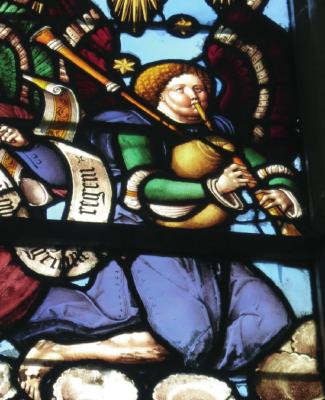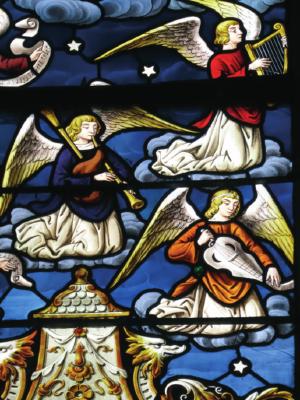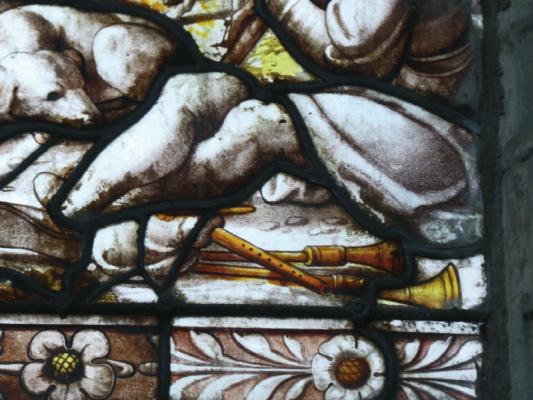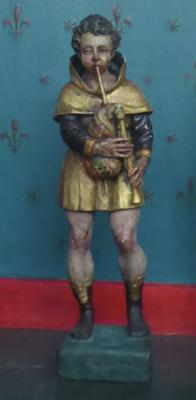The Bagpipe Society
Bagpipes of Troyes

A recent trip to the East of France (for reasons not unconnected with instrument making) delivered an unexpected bonus for me; a magnificent series of stained glass windows in and around Troyes, showing bagpipes together with other instruments.
A particularly interesting feature is that many of the windows are dated.
Most come from the 15th and 16th centuries, and that's particularly interesting as this is the period during which lathe technology advanced with the creation of the flywheel (converting reciprocal to circular motion) enabling finer, more ornate turning than was possible with the pole lathe.
Troyes was a wealthy medieval city. Henry V of England married Catherine de Valois here, Pope Urban IV was born here (Jacques Pantaléon, son of a cobbler and a prominent example of medieval social mobility). Troyes started as the capital of the Counts of Champagne, held a major trade fair (also giving its name to the Troy ounce), and during the Hundred Years War became the de facto capital of France. It's not a surprise, then, that the historic city is full of fine Renaissance mansions and Gothic churches. But it was a surprise to me just how many bagpipes were on display, and how fine was the quality of the depictions.

The Cathedral has a window of 1524 showing a curly-headed angel with puffed cheeks playing a set of pipes with a chunky chanter and what appears to be a conical drone. The details of the drone are exquisite; the drone is in two parts with a separate bell, and has what appear to be turned ivory rings at the joints and at the end of the bell. The detail of the chanter is less easy to see, but it appears quite girthy, with a pronounced flare suggesting a conical bore. Even the bag is beautifully depicted, with the slight dent the arm makes in it, the wrinkling around the mouthpiece and chanter top, and even the tying-in of the chanter clearly shown. Just above, there's a gurdy-playing angel. On the other side of the window, a rebec playing angel joins a shawm player. Do I believe in a bagpipe with ivory joints? I'm not sure. The date is a good 150 years before the Hotteterres, and even slightly later than this date the only jointed instruments I'm aware of are bass flutes with turned wooden ornament at the joint. It may be that a restoration is responsible for the different colouring. What's certain is that we are looking at a multi-jointed drone, perhaps 60-70 cm in length (which is a challenge to get out of one piece of wood).
I nearly missed the best of these depictions (in Saint-Pantaléon) having looked at the shepherds in the scene of the Annunciation to the Shepherds, and been disappointed to see not a single one of them playing his pipe.

But of course not! It's not every day an angel appears to you and your mates, so of course you put your bagpipe down carefully and listen to what the angel has to say … and here is his pipe. Exactly at head height, exactly horizontal and parallel with the border of the window, just so that you notice it. The chanter appears to be cylindrical, with quite thin walls and seven finger holes. The two parallel drones have cylindrical bodies, then a wider part that looks almost like the fontanelle of a shawm, and finally a flared bell marked by a number of turned rings.
Another window in Saint-Pantaléon, I would guess from the same workshop, shows an angel playing the flute. Tenor flutes are one of the most common instruments shown in windows of the 15-16 century in this area, though the placement of the finger holes here is suspect.
Many of the piping angels are shown paired with gurdy playing angels. This might not come as a surprise in nineteenth century Morvan or Berry, but in sixteenth century Champagne, it does. For instance, in the window of the Coronation of the Virgin in Sainte-Madeleine, there is a whole cohort of musician angels; rebec, flute and lute are shown on one side, with the bagpipe and gurdy shown together with a harp on the other. That might sound an odd combination, but a medieval harp with bray pins ('harpions' in French) to give it a buzzing sound might well fit this loud consort.
This window was restored in 1921, so I wouldn't want to place too much reliance on the representations of the instruments, but this bagpipe seems similar to the one shown in the cathedral, only without the detailed turnings of the drone.
A short drive away is Chaource, now a sleepy country town best known for its creamy cow's milk cheese, but once a rich fief of the Dukes of Burgundy.

The great attraction here is the Entombment of Christ, a life-size group of figures in a dim crypt, but the church is a treasure house of alabaster carving, stained glass, and not just one but two Christmas cribs, dating from 1540.
(One represents the Adoration of the Shepherds, the other the visit of the Magi, with an elegant and disdainful black dromedary.)
And here was a lovely surprise; a stocky little shepherd in a tunic, his chunky bare legs on display, and playing the pipes. The thick, flared chanter and the swan neck of the bag are similar to those shown in Troyes, but this bagpipe is droneless. He's playing right hand on top - that seems very common in almost all these representations.
On the way home we stopped at Bar-sur- Seine, where the huge nineteenth century watermill is currently being restored, its timber frame standing proudly and skeletally tall. In the church there was just time for two last instruments - a nice depiction of the 'Swiss pair' of tenor flute and drum in one of the windows.
And yet the bagpipe in Champagne appears to have died out before the 19th century; I can't find any trace of a surviving tradition, unlike in Berry, Auvergne or Limousin. But for a couple of hundred years, it seems to have been a nest of pipers - at least if we can believe the evidence of the stained glass.
Additional note: Looking at Jean-Luc Matte's Iconographie de la Cornemuse en France, there's another 16c stained glass depiction of vielle and bagpipe at Rigny-le-Ferron, 40km west of Troyes. Again, a single drone, and both drone and chanter with pronounced flare.
From Chanter Winter 2022.
- Data Processing Notice (GDPR)
-
@BagpipeSociety on X (formally known as Twitter)
-
TheBagpipeSociety on Instagram
-
 BagpipeSociety on Facebook
BagpipeSociety on Facebook
Something wrong or missing from this page? Let us know!
